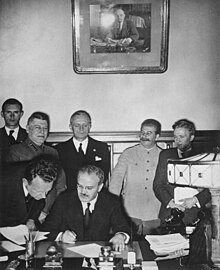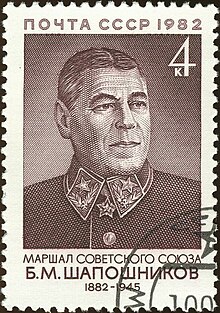Boris Michailowitsch Schaposhnikov

Boris Shaposhnikov ( Russian Борис Михайлович Шапошников ., Scientific transliteration Boris Michajlovič Šapošnikov ; born September 20 . Jul / 2. October 1882 greg. In Zlatoust , Ufa Governorate ; † 26. March 1945 in Moscow ) was a Marshal of the Soviet Union .
Life
In the period from 1893 to 1900 he attended the trade school in Krasnoufimsk , and from 1901 the officers' school of the Tsarist army in Moscow. In 1903 he left this with the rank of sub-lieutenant . From 1903 to 1907 he served in the 1st Turkestan Battalion , which was stationed in Tashkent , and was promoted to lieutenant in 1906 . From 1907 to 1910 he attended the General Staff Academy . In 1910, after graduating from the General Staff Academy , he was promoted to staff captain in category I. He then returned to his old regiment in Tashkent until he was transferred to the General Staff in 1912 and transferred to the position of senior adjutant in the rank of captain to the staff of the 14th Cavalry Division. After he was briefly deployed in 1915 as a staff officer with the Quartermaster General of the Northwestern Front Bonsch-Brujewitsch , he was Chief of Staff of the Independent Cossack Brigade from November 1915 . In December of the same year he became a lieutenant colonel .
After several assignments as chief of staff from 1916 to 1917, he was promoted to colonel in August 1917 . From September of the same year he commanded the 16th Mingrelian Grenadier Regiment.
In 1918, Shaposhnikov fell ill, was demobilized and accepted a position as court secretary. In May of this year he nevertheless joined the Red Army and on the day of his entry was appointed Deputy Chief of Operational Administration of the Staff of the Supreme War Council. In November 1918 he became deputy head of special correspondence of the Supreme Military Inspectorate of the RSFSR . From 1919 he took on the role of First Deputy Chief of Staff to the People's Commissar for Military and Naval Affairs of Ukraine. A little later he took over the function of the head of the reconnaissance department of the field staff of the Revolutionary War Council , only to become head of operational administration a little later. In 1921, Shaposhnikov was appointed First Deputy Commander in Chief of the Red Army of Workers and Peasants and four years later he was appointed Commander in Chief of the Leningrad Military District. In 1927 he took the same position in Moscow , only to become chief of staff of the Red Workers and Peasants Army a year later.
In 1930 he was admitted to the CPSU by resolution of the Central Committee without completing the mandatory candidate period.
In 1931 he became commander in chief of the Volga military district and a year later commander and commissioner of the military academy "MW Frunze" . In 1935 he was Commander-in-Chief of the Leningrad Military District, with the rank of Army Commander 1st Rank (November 20, 1935).
In June 1937 he was a member of the military tribunal of the Secret Moscow Military Trial , which Marshal Tukhachevsky and eleven other generals of the Red Army sentenced to death . In the same year he became Chief of Staff and Deputy People's Commissar for Defense, which was followed in 1940 by the appointment of Marshal of the Soviet Union . He was the deputy of the People's Commissar for Defense for the construction of defense systems. In July 1941 he was again Chief of Staff for Zhukov , who was sent to the front .
In 1942, Shaposhnikov was relieved of his position as chief of staff for health reasons.
In June 1943 he became the commander of the Higher Military Academy .
Shaposhnikov enjoyed the trust of Stalin in particular since the 1930s . While Stalin otherwise only used the salutation “Comrade ...”, he addressed Shaposhnikov - and nobody else - by first and father names (“Boris Michailowitsch”).
Shaposhnikov was also extensively active as a writer. In addition to many military and military-historical treatises, his main work was: "The Brain of the Army", which was published in two parts from 1927 to 1929 and in 1987 in German in Berlin by the military publishing house of the German Democratic Republic .
Shaposhnikov is regarded as the "teacher" of the younger Soviet general staff officers of the Second World War , such as Vasilevsky , Antonov and Shtemenko .
Awards and honors (selection)
- Suworoworden 1st class (1944)
- Order of the Red Banner (1921 and 1944)
- Order of the Red Star (1934, 1938 and 1945)
- Order of Lenin (1940, 1942 and 1945)
After Shaposhnikov's death, his urn was buried on the Kremlin wall in Moscow.
Web links
- Literature by and about Boris Michailowitsch Schaposchnikow in the catalog of the German National Library
- Newspaper article about Boris Michailowitsch Schaposhnikov in the 20th century press kit of the ZBW - Leibniz Information Center for Economics .
| personal data | |
|---|---|
| SURNAME | Shaposhnikov, Boris Michailowitsch |
| ALTERNATIVE NAMES | Шапошников, Борис Михайлович (Russian) |
| BRIEF DESCRIPTION | Marshal of the Soviet Union |
| DATE OF BIRTH | October 2, 1882 |
| PLACE OF BIRTH | Zlatoust , Ufa Governorate |
| DATE OF DEATH | March 26, 1945 |
| Place of death | Moscow |

